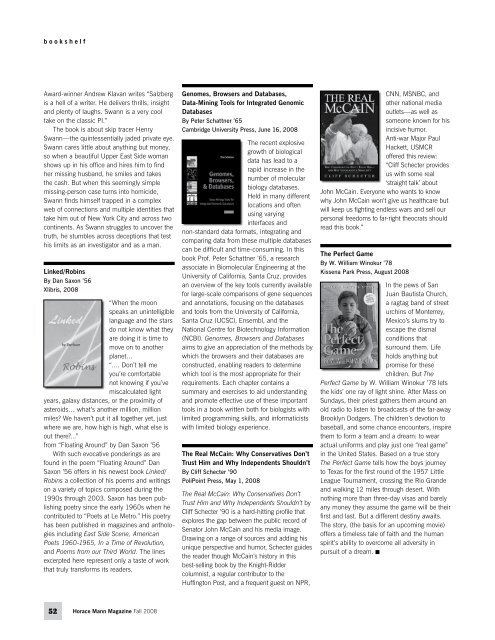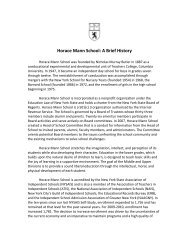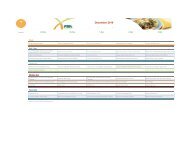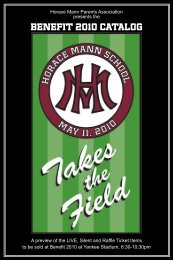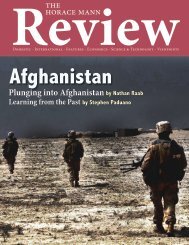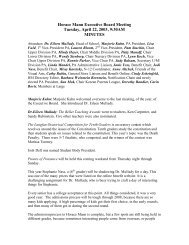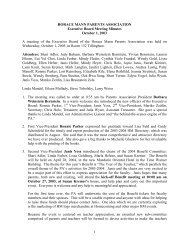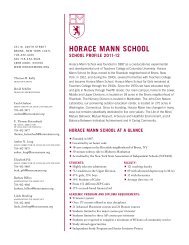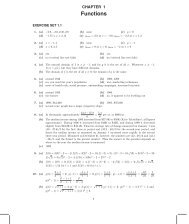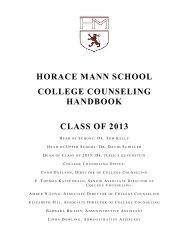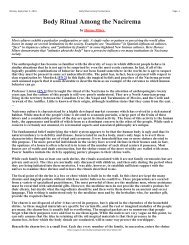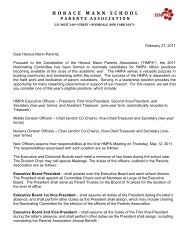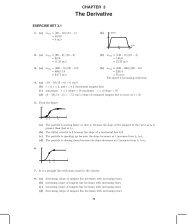Create successful ePaper yourself
Turn your PDF publications into a flip-book with our unique Google optimized e-Paper software.
ookshelf<br />
Award-winner Andrew Klavan writes “Salzberg<br />
is a hell of a writer. He delivers thrills, insight<br />
and plenty of laughs. Swann is a very cool<br />
take on the classic PI.”<br />
The book is about skip tracer Henry<br />
Swann—the quintessentially jaded priv<strong>at</strong>e eye.<br />
Swann cares little about anything but money,<br />
so when a beautiful Upper East Side woman<br />
shows up in his office and hires him to find<br />
her missing husband, he smiles and takes<br />
the cash. But when this seemingly simple<br />
missing-person case turns into homicide,<br />
Swann finds himself trapped in a complex<br />
web of connections and multiple identities th<strong>at</strong><br />
take him out of New York City and across two<br />
continents. As Swann struggles to uncover the<br />
truth, he stumbles across deceptions th<strong>at</strong> test<br />
his limits as an investig<strong>at</strong>or and as a man.<br />
Linked/Robins<br />
By Dan Saxon ’56<br />
Xlibris, 2008<br />
“When the moon<br />
speaks an unintelligible<br />
language and the stars<br />
do not know wh<strong>at</strong> they<br />
are doing it is time to<br />
move on to another<br />
planet…<br />
“…. Don’t tell me<br />
you’re comfortable<br />
not knowing if you’ve<br />
miscalcul<strong>at</strong>ed light<br />
years, galaxy distances, or the proximity of<br />
asteroids… wh<strong>at</strong>’s another million, million<br />
miles? We haven’t put it all together yet, just<br />
where we are, how high is high, wh<strong>at</strong> else is<br />
out there?...”<br />
from “Flo<strong>at</strong>ing Around” by Dan Saxon ’56<br />
With such evoc<strong>at</strong>ive ponderings as are<br />
found in the poem “Flo<strong>at</strong>ing Around” Dan<br />
Saxon ’56 offers in his newest book Linked/<br />
Robins a collection of his poems and writings<br />
on a variety of topics composed during the<br />
1990s through 2003. Saxon has been publishing<br />
poetry since the early 1960s when he<br />
contributed to “Poets <strong>at</strong> Le Metro.” His poetry<br />
has been published in magazines and anthologies<br />
including East Side Scene, American<br />
Poets 1960-1965, In a Time of Revolution,<br />
and Poems from our Third World. The lines<br />
excerpted here represent only a taste of work<br />
th<strong>at</strong> truly transforms its readers.<br />
Genomes, Browsers and D<strong>at</strong>abases,<br />
D<strong>at</strong>a-Mining Tools for Integr<strong>at</strong>ed Genomic<br />
D<strong>at</strong>abases<br />
By Peter Sch<strong>at</strong>tner ’65<br />
Cambridge University Press, June 16, 2008<br />
The recent explosive<br />
growth of biological<br />
d<strong>at</strong>a has lead to a<br />
rapid increase in the<br />
number of molecular<br />
biology d<strong>at</strong>abases.<br />
Held in many different<br />
loc<strong>at</strong>ions and often<br />
using varying<br />
interfaces and<br />
non-standard d<strong>at</strong>a form<strong>at</strong>s, integr<strong>at</strong>ing and<br />
comparing d<strong>at</strong>a from these multiple d<strong>at</strong>abases<br />
can be difficult and time-consuming. In this<br />
book Prof. Peter Sch<strong>at</strong>tner ’65, a research<br />
associ<strong>at</strong>e in Biomolecular Engineering <strong>at</strong> the<br />
University of California, Santa Cruz, provides<br />
an overview of the key tools currently available<br />
for large-scale comparisons of gene sequences<br />
and annot<strong>at</strong>ions, focusing on the d<strong>at</strong>abases<br />
and tools from the University of California,<br />
Santa Cruz (UCSC), Ensembl, and the<br />
N<strong>at</strong>ional Centre for Biotechnology Inform<strong>at</strong>ion<br />
(NCBI). Genomes, Browsers and D<strong>at</strong>abases<br />
aims to give an appreci<strong>at</strong>ion of the methods by<br />
which the browsers and their d<strong>at</strong>abases are<br />
constructed, enabling readers to determine<br />
which tool is the most appropri<strong>at</strong>e for their<br />
requirements. Each chapter contains a<br />
summary and exercises to aid understanding<br />
and promote effective use of these important<br />
tools in a book written both for biologists with<br />
limited programming skills, and inform<strong>at</strong>icists<br />
with limited biology experience.<br />
The Real McCain: Why Conserv<strong>at</strong>ives Don’t<br />
Trust Him and Why Independents Shouldn’t<br />
By Cliff Schecter ’90<br />
PoliPoint Press, May 1, 2008<br />
The Real McCain: Why Conserv<strong>at</strong>ives Don’t<br />
Trust Him and Why Independents Shouldn’t by<br />
Cliff Schecter ’90 is a hard-hitting profile th<strong>at</strong><br />
explores the gap between the public record of<br />
Sen<strong>at</strong>or John McCain and his media image.<br />
Drawing on a range of sources and adding his<br />
unique perspective and humor, Schecter guides<br />
the reader though McCain’s history in this<br />
best-selling book by the Knight-Ridder<br />
columnist, a regular contributor to the<br />
Huffington Post, and a frequent guest on NPR,<br />
CNN, MSNBC, and<br />
other n<strong>at</strong>ional media<br />
outlets—as well as<br />
someone known for his<br />
incisive humor.<br />
Anti-war Major Paul<br />
Hackett, USMCR<br />
offered this review:<br />
“Cliff Schecter provides<br />
us with some real<br />
‘straight talk’ about<br />
John McCain. Everyone who wants to know<br />
why John McCain won’t give us healthcare but<br />
will keep us fighting endless wars and sell our<br />
personal freedoms to far-right theocr<strong>at</strong>s should<br />
read this book.”<br />
The Perfect Game<br />
By W. William Winokur ’78<br />
Kissena Park Press, August 2008<br />
In the pews of San<br />
Juan Bautista Church,<br />
a ragtag band of street<br />
urchins of Monterrey,<br />
Mexico’s slums try to<br />
escape the dismal<br />
conditions th<strong>at</strong><br />
surround them. Life<br />
holds anything but<br />
promise for these<br />
children. But The<br />
Perfect Game by W. William Winokur ’78 lets<br />
the kids’ one ray of light shine. After Mass on<br />
Sundays, their priest g<strong>at</strong>hers them around an<br />
old radio to listen to broadcasts of the far-away<br />
Brooklyn Dodgers. The children’s devotion to<br />
baseball, and some chance encounters, inspire<br />
them to form a team and a dream: to wear<br />
actual uniforms and play just one “real game”<br />
in the United St<strong>at</strong>es. Based on a true story<br />
The Perfect Game tells how the boys journey<br />
to Texas for the first round of the 1957 Little<br />
League Tournament, crossing the Rio Grande<br />
and walking 12 miles through desert. With<br />
nothing more than three-day visas and barely<br />
any money they assume the game will be their<br />
first and last. But a different destiny awaits.<br />
The story, (the basis for an upcoming movie)<br />
offers a timeless tale of faith and the human<br />
spirit’s ability to overcome all adversity in<br />
pursuit of a dream. $<br />
52 <strong>Horace</strong> <strong>Mann</strong> Magazine Fall 2008


